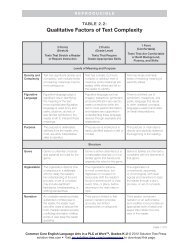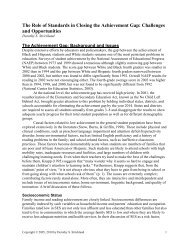Global Education Digest 2012 - International Reading Association
Global Education Digest 2012 - International Reading Association
Global Education Digest 2012 - International Reading Association
You also want an ePaper? Increase the reach of your titles
YUMPU automatically turns print PDFs into web optimized ePapers that Google loves.
SECTION 1 / Policy design and implementation of compulsory education systems<br />
out-of-school rate of all regions. In contrast, South<br />
and West Asia has made strong gains over the past<br />
decade. The reported number of out-of-school<br />
children fell by two-thirds, from 40 million to 13<br />
million between 1999 and 2010. This decrease was<br />
primarily due to progress made in India. Currently the<br />
out-of-school rate in South and West Asia is 7%.<br />
Slightly more than one-quarter of the global out-ofschool<br />
population live in the remaining six regions:<br />
East Asia and the Pacific, the Arab States, Latin<br />
America and the Caribbean, North America and<br />
Western Europe, Central and Eastern Europe and<br />
Central Asia. Together, these regions account for<br />
16.8 million primary school-age children who are not<br />
attending school.<br />
In 2010, an estimated 71 million lower secondary<br />
school-age children were out of school worldwide.<br />
This figure has remained relatively high over the past<br />
several years, despite a reduction in the previous<br />
decade. In 1999, there were 101 million lower<br />
secondary school-age children not attending school.<br />
The regions with the highest shares of the global<br />
out-of-school figure for this age group in 2010 were<br />
South and West Asia (31 million), sub-Saharan Africa<br />
(22 million) and East Asia and the Pacific (10 million).<br />
While in total approximately 131 million children<br />
of primary and lower secondary school age are<br />
currently out of school, this does not mean that they<br />
have never entered school. In fact, many out-ofschool<br />
children have had some exposure to formal<br />
FIGURE 1<br />
How many primary school-age children are out of school?<br />
Distribution of out-of-school children by type and region and absolute number of children out of<br />
school, 2010<br />
Left school Likely to enter school in the future Unlikely to ever enter school Children out of school<br />
(in millions)<br />
Sub-Saharan Africa<br />
20 25 55<br />
30.6<br />
South and<br />
West Asia<br />
45 7 49<br />
13.3<br />
East Asia and<br />
the Pacific<br />
47<br />
38 15<br />
6.6<br />
Arab States<br />
11<br />
41 49<br />
5.0<br />
Latin America and<br />
the Caribbean<br />
7 56 38<br />
2.7<br />
North America and<br />
Western Europe<br />
19<br />
79 2<br />
1.3<br />
Central and<br />
Eastern Europe<br />
9<br />
55 36<br />
0.9<br />
Central Asia<br />
8<br />
41 51 0.3<br />
WORLD<br />
26 27 47 60.7<br />
0 20 40 60 80 100<br />
Distribution of primary school-age children out of school (%)<br />
Source: UNESCO Institute for Statistics database.<br />
10

















